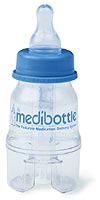 medibottle Article Abstracts
medibottle Article Abstracts
- The Wall Street Journal (Front Page), September 19, 1996
- Woman's World, July 1997
- Parents, August 1997
- Ambulatory Child Health, Volume 3 - Number 1, Part 2 - 1997
- The Wall Street Journal - "A SICK BABY moves his parents to invent a baby-bottle medicine dispenser"
- Woman's World - "Sneaky New Ways To Make The Medicine Go Down"
- Parents - "Help The Medicine Go Down"
- Ambulatory Child Health - Infant Acceptance and Effectiveness of a New Oral Liquid Medication Delivery System. DM Kraus, LA Stohlmeyer, PR Hannon.Departments of Pharmacy Practice and Pediatrics; University of Illinois at Chicago, Chicago, IL
Mark and Lori Burchett, a Chicago couple who combined a baby bottle and an oral syringe to help their seriously ill infant swallow medicine are grand-prize winners in a contest run by specialty retailer Hammacher Schlemmer to find the best new products of 1996. Their patented medibottle has a center-sleeve with an air-tight pump dispenser that jets medicine to the tip of the nipple. A baby sucks in the medicine but tastes only the more-palatable liquid in the bottle.
The medibottle features and oral dispenser made by Baxa Corp. of Englewood , Colo. The bottle is already being used in some hospitals, and the Burchetts expect to have a retail version out soon. Hammacher Schlemmer says it will consider the bottle for its catalog. Meanwhile, the Burchetts say their son Jake, now four years old, is "doing great."
© 1996, Dow Jones & Company, Inc. All Rights Reserved.
Any parent can tell you it's never easy getting liquid medicine into a reluctant patient--at least, not until now.
Not surprisingly, it took real-life parents to invent breakthrough ways to administer doctors' orders. At first, medibottle, looks like a baby bottle except that it contains an internal tube that can hold a plunger full of medicine.
You fill the bottle with formula, juice or water, then load the tube with the medicine. After the baby begins drinking, you sneak the medication in with short, quick pushes on the plunger. About 30 squirts over the course of a minute delivers a teaspoon. "Some of these medicines taste absolutely awful and kids just refuse to take them," observes pediatrician Joan Frankson, M.D. "With the medibottle, the child doesn't even realize he's getting the medicine."
Getting a sick baby to take her medicine can be a challenge. Now there's help: medibottle combination bottle/medicine dispenser, lets a baby drink her medicine along with her formula, milk, or juice.
The medibottle is simple to use: Fill it with 3 1/4 ounces of your baby's beverage. Then, load the calibrated oral syringe with the proper dosage of medicine and insert it into the bottle's plastic sleeve. As your baby drinks, push the plunger at the bottom of the syringe to release the medicine in small amounts. It takes about a minute and a half to give a teaspoon's worth; the equivalent of 30 squirts.
Most medicines can be taken with formula, milk, or juice, says Colleen Habing, R.N., who uses the medibottle to administer bitter-tasting drugs to children younger than 2 at Children's Memorial Hospital, in Chicago. Still, you should always check with your child's doctor and your pharmacist. The medibottle costs about $17. For information on where to purchase it, call 800-848-8622.
A new pediatric oral liquid medication delivery system, medibottle (The Medicine Bottle Company, Chicago), has the shape of a baby bottle but contains an inner sleeve that holds a medication syringe. The infant recieves a premeasured dose of medication while suckling formula through the nipple of the device.
OBJECTIVES: To evaluate infant acceptance and effectiveness of the medibottle® and to assess a new pediatric oral liquid medication acceptance scale (MAS), a 10 point summative index with 5 behavioral elements.
DESIGN: Part l: Development and preliminary field testing of MAS; Part 11: Open-label clinical study using medibottle® to deliver a single acetaminophen dose.
PARTICIPANTS: Part l: 54 pediatric nurses; Part II: 20 consecutively sampled healthy bottle-fed infants (mean age = 4.8 + 2.7 months) receiving vaccines at an urban university clinic.
OUTCOME MEASURES: 1) internal consistency and inter-rater reliability of MAS; 2) percent of dose delivered; 3) level of infant acceptance of medibottle®.
RESULTS: Testing of MAS revealed a coefficient alpha (Cronbach) = 0.95, with high correlations between raters (r range = 0.81-0.97, p(0.01). Ten of 20 infants (50%) had a history of either gagging/choking or needing restraint when receiving oral medications (majority with medicine dropper use). 16/20 infants (80%) received 100% of dose with medibottle®. Infants' level of acceptance of new device was high (median MAS score= 9 (10 = highest)). 17/20 (85%) of infants did not gag or need to be restrained.
CONCLUSIONS: A new pediatric oral liquid medication acceptance scale has high internal consistency and inter-rater reliability. The medibottle® offers a unique option for effective drug delivery to infants and has a high level of infant acceptance: An open-label, cross-over design study comparing medibottle® with oral medication syringe technique is ongoing.






